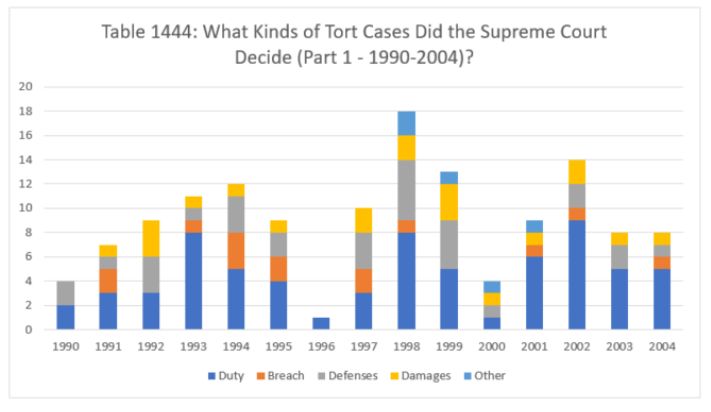For the past few months, we've been taking a detailed look at the Court's results record and the individual Justices' voting records in various areas of the civil and criminal law. Today, we begin a new series of posts drilling down on that earlier project to specific sub-areas of law. What are the sub-areas within each field from which the Court draws its cases?
We begin by dividing the tort docket into five categories, based on the primary issue as to which the Court granted review: duty, breach, defenses, damages and other (primarily procedural questions specific to tort). For anyone unfamiliar with the type of chart below, the height of each bar is the number of tort cases the Court decided in that year. Each differently colored segment of the bar describes the number of cases in each sub-area.
Between 1990 and 2004, the Supreme Court decided 137 tort cases. Nearly half involved questions of duty (68 cases). The second most common issue was defenses - 30 cases. Duty cases only spiked in a few of these fifteen years - 1993 (8 duty, 1 defenses), 2001 (6 duty, 0 defenses) and 2002 (9 duty, 2 defenses). Otherwise, the two areas were close in the docket each year. The Court decided 20 cases in this period involving issues of tort damages. The damages cases were evenly spread through the period - only in 1990 and 1996 did the Court decide no damages cases. The Court decided 14 cases involving issues of breach and causation. Breach didn't appear on the docket at all in 1990, 1992, 1996, 1999, 2000 or 2003. Finally, the Court decided five cases in our "other" category, all of them between 1998 and 2001.

Join us back here tomorrow as we review the tort docket for the years 2005 through 2019.
Image courtesy of Flickr by Ken Lund (no changes).
Originally published in California Supreme Court Review.
The content of this article is intended to provide a general guide to the subject matter. Specialist advice should be sought about your specific circumstances.
